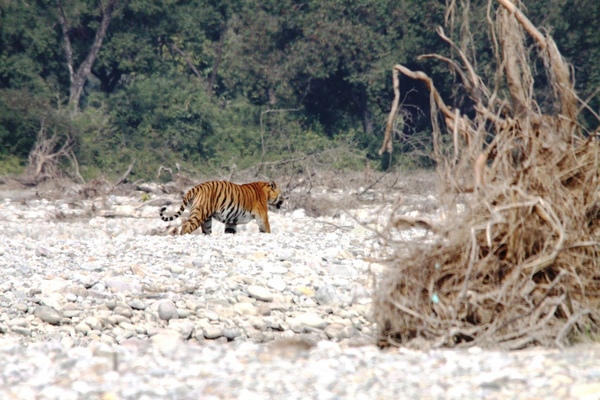
First Tiger Photos Snapped in India Corridor

Conservationists snapped the first known images of a Bengal tiger in an area of northern India that is important habitat for the endangered species.
A team working with the conservation group WWF documented the tiger crossing the Kosi River in an area called the Terai Arc Landscape in October 2011. The river divides the Corbett Tiger Reserve from the Ramnagar Forest Division to its east. The area acts as a wildlife corridor, or link between habitats for important species that can be cordoned off into smaller populations by development.
Project officer Debmalya Roy Chowdhury was walking along the river with two colleagues, Chandar Singh Neg and Tara Thaplial, when they reached one of the camera traps that was part of the Kosi Corridor Monitoring Study.
"Just after crossing the river bed, Tara screamed out “Sir, tiger-tiger!” I looked up. How I felt at the moment is very hard to describe in words. There was a huge, mature male tiger walking along the river bed in that broad daylight attempting to move into the Corbett Tiger Reserve," Chowdhury said in a WWF statement.
"The big cat was few hundred meters away from us," he continued. "After a few seconds of being perplexed, I started clicking off photographs. The tiger spotted us and tried to take cover, but realising there being none it turned back towards our camera point and disappeared into the jungle."
The team then made its way to the nearby camera trap, following the tiger's tracks.
"This was the most memorable on-foot sighting of a tiger I have ever had in my life — and it is probably the best direct evidence we have to document how well the River Kosi corridor is working," Chowdhury said.
Sign up for the Live Science daily newsletter now
Get the world’s most fascinating discoveries delivered straight to your inbox.
A tiger census conducted in India by WWF last year showed that the Ramnagar Forest Division had "the highest density of tigers outside a protected area anywhere in India and perhaps the world," said Joseph Vattakaven, a WWF tiger coordinator.
However, there is cause for concern with the tigers and development increasingly encroaches on the corridor. And "the fact that these tigers are in a non-protected area increases the urgency for measures to protect them," Vattakaven said.
This story was provided by OurAmazingPlanet, a sister site to LiveScience.










